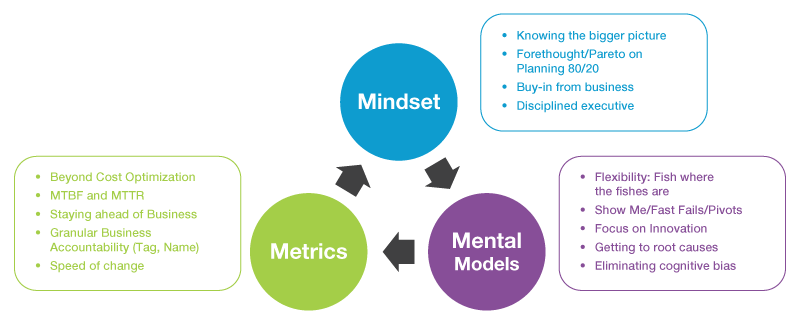On-demand cloud native models continue to offer immense opportunities for enterprises to stay relevant to customers, innovate business models with speed, and create platform-driven agility. Moving beyond cost optimization, these models focus on resilience to threats and responsiveness to competitive market opportunities.
We are seeing increased pace of adoption and a decisive intent to move to cloud native models across even highly regulated Industries - including financial services and healthcare. The drivers vary from cost pressures (resulting in knee-jerk exits from data centers) to C-level sponsored digital transformations, specific innovation initiatives, and a more systematic hedge to totally staying on-prem.
Whatever be the reason for the shift, the journey is laden with deep set of challenges, as enterprises reimagine their core and break out of relying solely on legacy processes and systems. What we observe is a need to simplify, and process and execute for what lies ahead - given the great divide between the speed of prescribed changes by cloud providers and the inertia and readiness of enterprises.
Enterprise adoption vs cloud provider innovation – a deep chasm in pace
Cloud providers are on an incredible run in bringing out faster, better and less expensive services as they constantly add value and raise the bar on innovation in the areas of computing, storage, analytics, machine learning and emerging managed services. All public cloud providers are pushing a larger vision, backed by high quality of services that are designed to drastically simplify mundane tasks. Change has thus become easy. What requires forethought and preparation is the thinking to prepare for the change, transition the operating model and stabilize operations.
Various unique factors distinguish enteprises that have successfully adopted cloud at their new core - such as their technology platform of choice around kubernetes, specialized data lakes on cloud, low latency systems etc. However, there is a core set of principles and culture-related items that sets these leaders apart when it comes to successfully adopting cloud native models.
In this blog, we describe three core tenets of cloud culture for a solid operating model – growth mindset, adaptive mental models and metrics that matter.

An entrepreneurial, insurgent on-demand mindset
A cloud-native mindset is all about making entrepreneurial decisions with confidence, and assuming your systems are resilient and responsive to your business needs. Beyond the technology frame of driving elegant architectures, or a solutioning skill in building a 12-factor distributed app with externalized configurations, a cloud native mindset is all about embracing an across-the-board ‘on demand’ mindset - from the developer to business leader, and to the CEO.
At the heart of it all, it is about redesigning the enterprise value chain, building a fast-decisioning DNA and moving towards an agile entrepreneurial enterprise. A cloud-native mindset allows processes and leadership to stay nimble and live through the vagaries of on-demand scaling of distributed systems, and truly embracing failures that come by as well. The eventual consensus architecture is after all built not just for the systems to scale but also to bring the enterprise stakeholders and decision-makers to get things done at a faster pace. It is a ‘let-me-show-you-how-it-works’ culture in what you decide to focus on, and in the value and differentiation it drives for the enterprise.
For example, a client Engineering VP of a leading financial services organization was excited to move monolithic applications to a cloud-native microservices model on a hybrid multi-cloud platform, through domain-driven design. Their engineering teams also felt empowered in quickly being able to redesign the entire mortgage application as a microservices model. When it came to take the application to production, however, the business and execution-related stakeholders were just not ready. Business was not fully clear on how value was tied to this move. The operations, security and business teams were simply not equipped to make rapid decisions on what really mattered – and the program got caught in a web of ‘what-ifs’. It took two long years from redesign and readiness to deployment with exposure control to a very limited set.
The bottom line here is not about the 12-factor hybrid multi-cloud distributed technology at all. It is the cloud-native mindset that enterprise and leadership need to adapt, and make quick and agile decisions, that matters most. The need for such an agile mindset is critical – for technology alone does not result in success.
Experimentation and adaptive mental models for resilience and responsiveness
As enterprises move their entire business operations to cloud, the entire value chain must become highly responsive and resilient. Given the ease of change, dealing with the cascading effects that amplify and debilitate operations becomes central. This is where a data-driven DevOps mindset can enable decision makers to anticipate and leverage information for seamless operations on the cloud.
The more successful organizations apply the well-understood Occams Razor principle in their feature prioritization - “Go fishing where the fishes are”. They rapidly allocate enterprise development and support bandwidth to where the money is.
A second model rests on how engineers use cloud to envision and bring next-generation experiences to customers, build prototypes, roll out through exposure controls and roll back quickly within seconds, if results are not satisfying. They augment this with rapid experimentation and fail fast to reimagine their product innovation process.
A third adaptive mental model is based on Hanlons’ Razor principle, which is particularly important in today’s security-focused IT landscape. It makes a quick judgement call between a malicious and an accidental error - and designs security controls leveraging audit logs and account granularity that cloud platforms provide.
SRE engineers can now effectively and consistently discover the proximate cause and provide powerful and valuable insights to decision-makers on the ultimate cause through systemic monitoring. This totally changes the way enterprises discover and approach issue resolutions as they focus on innovation.
Finally, we observe that cloud native automation eliminates a lot of broken silos and human errors, thereby drastically reducing cognitive bias from enterprise systems. Data-driven insights from cloud native operations enable clients to accurately judge situations. Importantly, we see that they are able to make objective and hard decisions if required, instead of stakeholder bias influencing interpretations.
Driving metrics that matter.
On-demand cloud operations provide an opportunity to drive the most relevant and important metrics that matter to your business. Starting with IT and extending to other functions, we observe that as enterprises become more comfortable with the cloud, they start showing an increased focus on their future by leveraging insights that are well supported by data, operating models and dashboards. It gives them time to ask the right questions to guide their enterprises. They know to move beyond the initial focus on annual cost reduction programs to a future of continuous optimization.
An example that we recently encountered concerned the KPI on how long it takes to resolve a problem (MTTR-Mean Time to Recovery). By simply reducing MTTR by 80 percent, the enterprise realized significant benefits - resulting in elevated confidence to sense and respond from a CMO’s viewpoint.
For another client, this metrics-based approach allowed them to measure time taken from Idea to production (measure pace of innovation), rather than simply measure the number of Ideas launched.
A third example is about a CIO and her team looking at developer productivity across vendor teams. They are now able to examine and contrast the time spent by developers on coding, quality of code written and the ensuing technical debt. This contrasts to prior efforts where time was primarily spent on infrastructure-building environments and related concerns.
As clients mature, we find that their ability to be granular and track each business stakeholder based on their charter, and to keep up and ultimately fund transformation puts IT in a commanding position.
In summary, this shift to measure and act based on metrics that matter becomes key in driving the ultimate success of enterprise-wide cloud adoption. It ensures high responsiveness to opportunities and resilience to disruptions with speed - in both business and exogenous events such as pandemic and other security threats. It also ensures accountability backed by responsibility.
In conclusion
Over the past years, several enterprises have launched initiatives through a standard approach of SaaS, lift-and-shift migrations of 6Rs to the cloud, and point-optimization initiatives. What they have failed to recognize is that the cloud needs to be adopted as a holistic change. This calls for a fundamentally different and systemic approach to transformation. Business agility must be driven by embracing cloud-native in spirit. This will allow organizations to go beyond technology and compete with the likes of Netflix or Amazon. Running a successful business operations on the cloud requires a strong cloud-native culture and DNA founded on a three-pronged approach of mindset, mental models and metrics. This is what will drive business value and ensure success through agility, efficiency and effectiveness.


